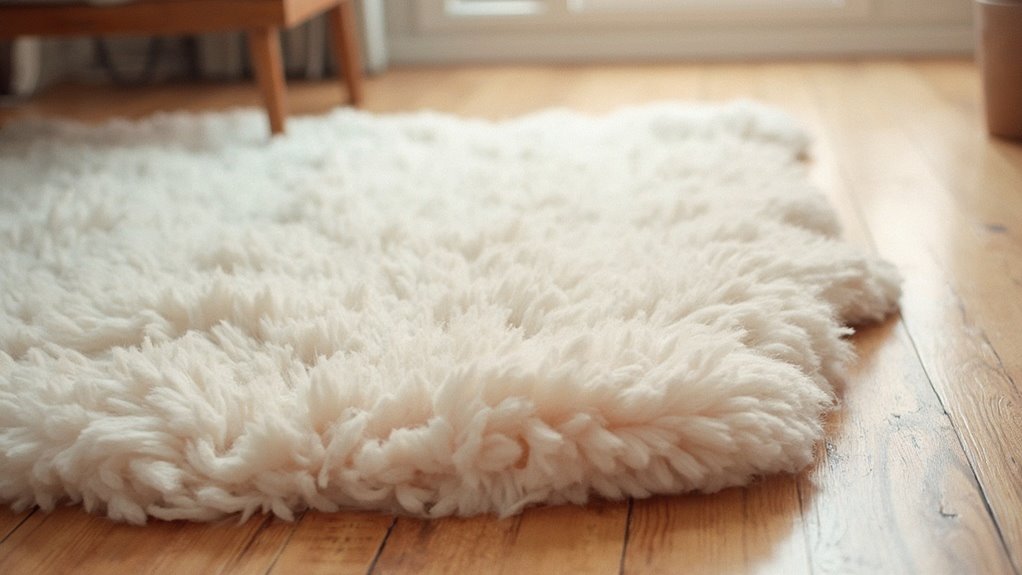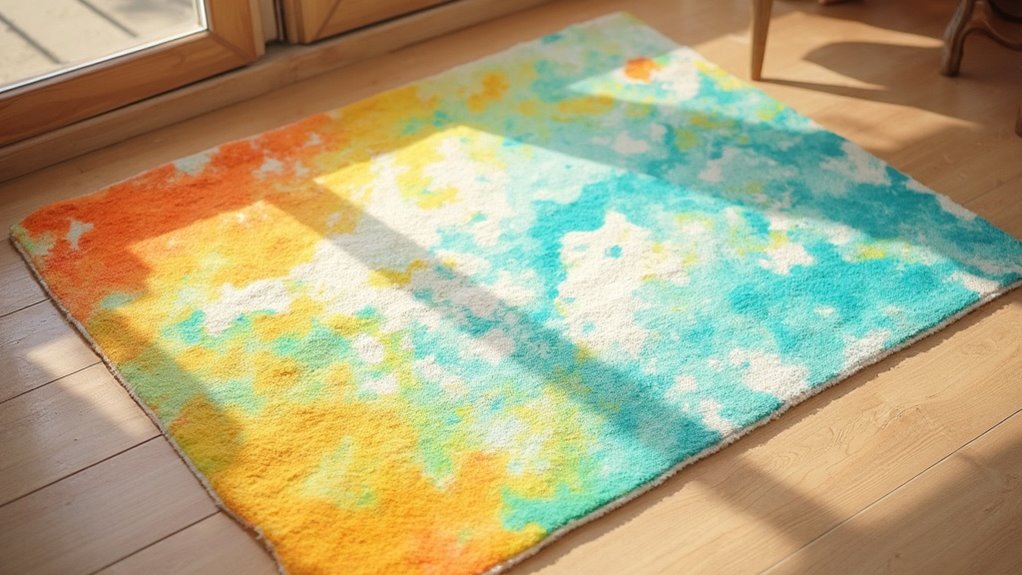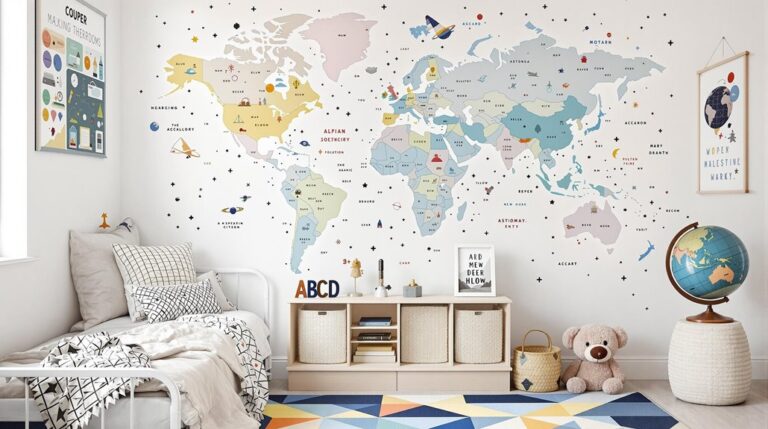The ultimate kids' room rug blends safety, durability, and imagination. Natural fibers like wool offer hypoallergenic protection, cushioning falls and resisting dust mites. Opt for machine-washable materials with non-slip backing to withstand energetic play and simplify cleaning. Size matters: choose rugs that fit the room's dimensions, from 6' x 9' for twin beds to 8' x 10' for fuller spaces. Select designs that spark creativity—think interactive patterns with letters, numbers, or playful shapes that transform floors into learning landscapes. Consider stain-resistant synthetic options that balance affordability with resilience. Your perfect rug awaits just beyond the horizon of ordinary floor coverings.
Briefly keys
- Choose hypoallergenic, natural fiber rugs like wool or cotton to ensure safety, comfort, and resistance to dust mites and allergens.
- Select rugs with non-slip backing and low-pile designs to minimize tripping hazards and provide a safe play surface for children.
- Opt for machine-washable, stain-resistant materials that can withstand spills, high traffic, and frequent cleaning in active kids' environments.
- Pick rugs with educational or imaginative designs featuring letters, numbers, shapes, or themes that stimulate learning and creative play.
- Consider rug size carefully, matching dimensions to room layout and bed size (6' x 9' for twin beds, 7' x 10' for full beds) for optimal functionality.
Why Material Matters

Considering the pivotal role of materials in children's room rugs, parents and caregivers must prioritize safety, comfort, and practicality when selecting floor coverings.
Natural fiber benefits shine through materials like wool, cotton, and jute, which offer remarkable advantages for creating a nurturing environment.
The hypoallergenic properties of these fibers make them extraordinary choices for children's spaces. Wool, for instance, naturally repels dust mites and provides a soft, cushioned surface that protects against inevitable tumbles and play-related mishaps.
Cotton rugs breathe with delightful ease, creating comfortable environments that feel simultaneously protective and inviting.
Beyond immediate comfort, these materials deliver substantial health advantages. Natural fibers are free from harmful volatile organic compounds (VOCs), ensuring a clean breathing space for developing lungs.
Synthetic alternatives like polypropylene can also be safe when carefully manufactured, but they lack the inherent environmental credentials of their natural counterparts.
Ultimately, selecting the right rug material transcends aesthetic considerations. It's about crafting a safe, comfortable microenvironment where children can explore, play, and grow without unnecessary risks from toxic substances or uncomfortable surfaces. Artisan handwoven techniques ensure that natural fiber rugs maintain superior quality and craftsmanship, providing an additional layer of durability and care for children's spaces.
Durability That Withstands Playtime
In the dynamic world of children's room decor, a rug's durability becomes paramount when confronting the relentless energy of growing kids. Rug resilience isn't just a luxury—it's a necessity when tiny feet dance, tumble, and transform spaces into adventure zones. Fiber selection significantly impacts a rug's long-term performance and suitability for children's active environments.
Natural fibers like wool emerge as champions of playtime protection, offering remarkable durability with inherent stain resistance and flame-retardant properties. Its high moisture content and soft texture create a robust surface that withstands frequent usage while providing sound dampening and warmth.
Synthetic options like polypropylene and polyester complement this durability, presenting budget-friendly alternatives that resist stains and maintain lively colors.
Different materials bring unique strengths: sisal offers affordability and high-traffic endurance, while polyester provides soft, colorful comfort. Some rugs, crafted from recycled materials, even add an eco-conscious dimension to their protective qualities.
The key is selecting a rug that balances resilience with comfort—a surface that can absorb the enthusiastic jumps, sudden tumbles, and creative play of childhood while preserving its integrity and aesthetic appeal.
Ultimately, the right rug becomes more than a floor covering; it's a reliable companion in a child's daily adventures.
Perfect Size for Every Space

Selecting the perfect rug size transforms a child's room from merely functional to wonderfully functional, creating a harmonious balance between comfort and design.
Rug placement strategies are essential in achieving this delicate equilibrium, especially when considering room size considerations for different spaces like nurseries and bedrooms.
For twin-sized beds, a 6' x 9' to 7' x 10' rug works brilliantly, strategically positioned under the bottom two-thirds of the bed. Nylon fiber durability ensures these rugs withstand the energetic wear and tear of children's spaces.
Full-sized beds demand slightly larger rugs, ranging from 7' x 10' to 8' x 10', extending 18-24 inches beyond bed edges to create a plush landing zone.
Nurseries offer unique challenges, with rooms typically spanning 8×10 to 10×12 feet.
Here, versatility is key – small 3×3 accent rugs can punctuate play areas, while expansive 8×10 or 9×12 rugs can encompass the entire room, providing a soft canvas for childhood adventures.
Pro tip: Use masking tape to outline potential rug placements before committing.
This visual mapping guarantees you select a rug that not only fits physically but also enhances the room's aesthetic and functional landscape.
Shapes That Spark Imagination
Beyond precise measurements, the shape of a children's rug can transform a room from merely functional to a whimsical wonderland of imagination. Imaginative designs like car-shaped, star-shaped, and animal-themed rugs invite children into magical worlds of play and learning.
These playful patterns aren't just decorative; they're interactive learning tools that stimulate creativity and cognitive development. Geometric shapes offer more than aesthetic appeal—they become educational platforms. A circular rug with alphabet letters can become a dynamic learning zone, while a star-shaped carpet might inspire dreams of outer space exploration.
Sports enthusiasts will delight in soccer ball or basketball-themed rugs that reflect their passions, turning floor coverings into personal statements. The strategic choice of shape can dramatically influence a room's atmosphere. Round or oval rugs soften smaller spaces, creating gentle visual flow, while unconventional shapes like flowers or stars generate compelling focal points.
High-pile fluffy rugs in whimsical forms provide not just visual interest but also comfortable play surfaces that encourage exploration and imaginative adventures. These thoughtfully designed rugs transform ordinary rooms into extraordinary landscapes of discovery, where every shape narrates a tale and invites children to dream, learn, and play. Well Woven's collections, featuring stain-resistant materials, ensure that these imaginative spaces remain practical and easy to maintain.
Colors That Inspire Creativity

Every child's world bursts with color, transforming rugs into lively canvases that spark imagination and stimulate cognitive development. Color combinations become powerful tools for sensory engagement, inviting children to explore their creative potential through vivid visual experiences.
The strategic use of colors in children's rugs can profoundly influence emotional landscapes and learning environments. Warm hues like red and orange energize play spaces, while cool tones such as blue and green cultivate calm and introspection. These chromatic variations aren't merely decorative; they're developmental catalysts that encourage cognitive growth and emotional understanding.
Artistic exploration flourishes when children interact with multicolored rugs featuring educational elements. By mixing different shades and experimenting with color relationships, kids develop critical thinking skills and enhance their problem-solving capabilities. Educational rugs with alphabets, numbers, and shapes transform learning into an immersive, visually stimulating experience. Primary colors serve as foundational building blocks for understanding complex color interactions and creative expression.
Moreover, colorful rugs serve as dynamic platforms for self-expression. They invite children to engage their senses, inspire imagination, and create meaningful connections between visual perception and intellectual curiosity.
Through intentional color selection, these floor coverings become more than mere decorations—they're interactive learning tools that nurture creativity and cognitive development.
Comfort Beyond Soft Surfaces
While color stimulates creativity, the tactile experience of a rug plays an equally significant role in crafting an inviting children's space. Textural variety transforms a simple floor covering into a sensory landscape where children explore and engage with their environment. Hypoallergenic materials ensure that children can interact with rugs safely, reducing potential allergic reactions during play.
High-pile fluffy rugs offer more than just softness; they create a cushioned terrain for imaginative play and spontaneous floor activities. The sumptuous materials like wool and cotton provide warmth and comfort, acting as a tactile canvas for childhood adventures.
Different textures—from the plush hug of a wool rug to the structured weave of a flatweave design—invite children to interact physically with their surroundings.
Beyond mere surface comfort, rugs become dynamic play zones that adapt to children's changing needs. A car-shaped rug with a supple softness can transform into a racetrack, while a rug with animal motifs becomes an imaginary safari.
The strategic selection of materials guarantees these spaces are not just visually appealing but also functionally resilient.
Safety First

In the domain of children's room design, safety emerges as a paramount concern when selecting rugs. Parents must navigate a complex landscape of materials and certifications to guarantee their child's environment remains free from potential health risks.
Prioritizing non-toxic, hypoallergenic materials like organic wool, cotton, and natural fibers can greatly reduce exposure to harmful chemicals. Organic material research indicates that children exposed to fewer synthetic chemicals experience fewer respiratory and skin-related health issues.
Rug certifications play a critical role in validating product safety. Look for standards like ISO 9001, which guarantee quality management, and seek out rugs explicitly labeled as free from per- and polyfluoroalkyl substances (PFAS). These certifications provide reassurance that the chosen rug meets stringent health and safety requirements.
Practical safety considerations extend beyond material composition. A non-slip backing or strategically placed rug pad prevents accidental slips, while low-pile designs minimize tripping hazards.
Opt for breathable, chemical-free materials that resist moisture and potential allergen accumulation. Synthetic fibers like polyester offer additional benefits, combining stain resistance with durability.
Budget-Friendly Flooring Solutions
Parents seeking cost-effective flooring solutions for their children's rooms can find numerous affordable and practical options that balance budget constraints with durability and comfort.
Vinyl flooring emerges as a stellar choice, boasting remarkable vinyl versatility that allows homeowners to transform spaces with stylish, resilient surfaces that withstand the chaotic energy of childhood play. Low VOC emission materials ensure a safer indoor environment for growing children.
Laminate flooring offers another compelling alternative, championing laminate longevity with its impressive resistance to scratches and scuffs.
Its ability to mimic natural materials like wood and stone provides aesthetic flexibility without breaking the bank.
For those prioritizing comfort, cork flooring delivers a soft, sound-dampening surface perfect for little ones tumbling and exploring.
Carpet remains a timeless option, particularly solution-dyed nylon or Berber varieties that resist stains and wear.
Budget-conscious families can also explore synthetic fiber rugs, which provide excellent durability and easy maintenance at a fraction of the cost of natural materials.
Each flooring solution offers unique benefits, allowing parents to create inviting, functional spaces that protect both budgets and children's playful environments.
The key is selecting materials that blend practicality, affordability, and a touch of whimsy.
Maintenance Made Simple

Maintaining children's rugs requires strategic approaches that balance simplicity with effectiveness. Smart cleaning tips can transform potentially challenging maintenance into a manageable routine.
Machine washable rugs offer parents a lifeline, allowing easy handling of inevitable spills and messy accidents that come with childhood adventures.
Stain removal becomes less intimidating when armed with the right techniques. Gentle stain removers and mild detergents can tackle tough marks without compromising rug integrity.
Synthetic materials like polyester prove particularly forgiving, resisting stains and simplifying cleaning processes. Flatweave designs offer an additional advantage, preventing dirt and food crumbs from embedding deeply into fibers.
Routine maintenance extends beyond just cleaning. Choosing rugs with stain-resistant treatments and non-toxic materials guarantees both practicality and safety.
Skid-resistant backing adds an extra layer of protection during energetic play sessions. Regular washing not only keeps rugs hygienic but also removes potential allergens, creating a healthier environment for little ones.
Strategic material selection—whether wool, jute, or synthetic—can dramatically reduce maintenance stress. By prioritizing durability and ease of cleaning, parents can select rugs that withstand the chaotic, wonderful world of childhood while maintaining aesthetic appeal. Washable Play Rugs offer an innovative solution for parents seeking low-maintenance, high-performance floor coverings for children's spaces.
Learning Through Design
Colorful educational rugs transform traditional learning spaces into dynamic, interactive environments that captivate young minds. These thoughtfully designed floor coverings offer remarkable educational benefits by seamlessly integrating learning with play, turning ordinary rooms into extraordinary spaces of exploration and discovery.
Interactive features are the hallmark of these innovative rugs, which transform abstract concepts into tangible, engaging experiences. Children can hop across number lines, trace alphabets with their fingers, or explore intricate world maps—all while developing critical cognitive skills through playful interaction.
The tactile and visual stimulation provided by these rugs creates multisensory learning opportunities that make education feel less like work and more like an exciting adventure. Manufactured in Resaca, GA, these rugs exemplify American craftsmanship and educational innovation.
From STEM-themed designs that introduce scientific concepts to multicultural illustrations that celebrate diversity, these rugs serve as powerful educational tools. They encourage creativity, spatial awareness, and problem-solving skills through imaginative patterns and interactive elements.
Whether round, rectangular, or uniquely shaped, each rug becomes a canvas for learning, inviting children to engage with knowledge in a fun, immersive manner that sparks curiosity and makes education an enjoyable journey of discovery.
People are Asking
How Often Should I Replace a Children's Room Rug?
Based on foot traffic and wear, replace children's room rugs every 5-7 years. Implement regular rug maintenance tips and annual professional cleaning to maximize lifespan and preserve rug quality.
Can Rugs Help Reduce Noise in a Kid's Bedroom?
Up to 40% of indoor noise can be reduced with strategic rug placement. Thick wool or high-pile rugs provide excellent noise absorption and sound insulation, effectively minimizing disruptive sounds in a child's bedroom environment.
Are Custom-Sized Rugs Worth the Extra Expense for Children's Rooms?
Custom-sized rugs offer tailored fit and design advantages, though affordable alternatives exist. For children's rooms, the precise sizing and potential educational benefits can justify the investment when balanced against budget constraints.
Do Rug Pads Really Make a Difference Under Kids' Area Rugs?
Rug pads greatly enhance safety and comfort by preventing slips, protecting floors, and providing cushioning. They are essential for reducing wear and minimizing potential injury risks in high-traffic areas.
How Can I Prevent My Child's Rug From Fading Quickly?
Safeguard your child's lively floor companion by implementing strategic rug care techniques, utilizing UV-blocking window treatments, rotating the rug periodically, and applying protective sprays to minimize sun-induced color degradation.
Wrapping up
In the domain of children's room design, selecting the ideal rug transcends mere aesthetic considerations. The right floor covering serves as a functional foundation that nurtures creativity, guarantees safety, and withstands the dynamic energy of childhood play. By carefully evaluating material quality, size, shape, color, and maintenance requirements, guardians can transform floor spaces into lively learning environments that inspire imagination and support developmental growth.




